Barriers to Selling Electric Vehicles and Strategies for Overcoming Them
VerifiedAdded on 2023/01/03
|10
|2341
|59
AI Summary
This article discusses the barriers faced in selling electric vehicles, including low demand and limited driving distance. It explores strategies to overcome these barriers, such as reducing production costs, improving battery capacity, and increasing charging station coverage. The importance of government assistance and the role of subjective norms in promoting electric vehicles are also examined.
Contribute Materials
Your contribution can guide someone’s learning journey. Share your
documents today.

Running head: PARAPHRASING
Paraphrasing
Student’s name:
University:
Author’s note:
Paraphrasing
Student’s name:
University:
Author’s note:
Secure Best Marks with AI Grader
Need help grading? Try our AI Grader for instant feedback on your assignments.
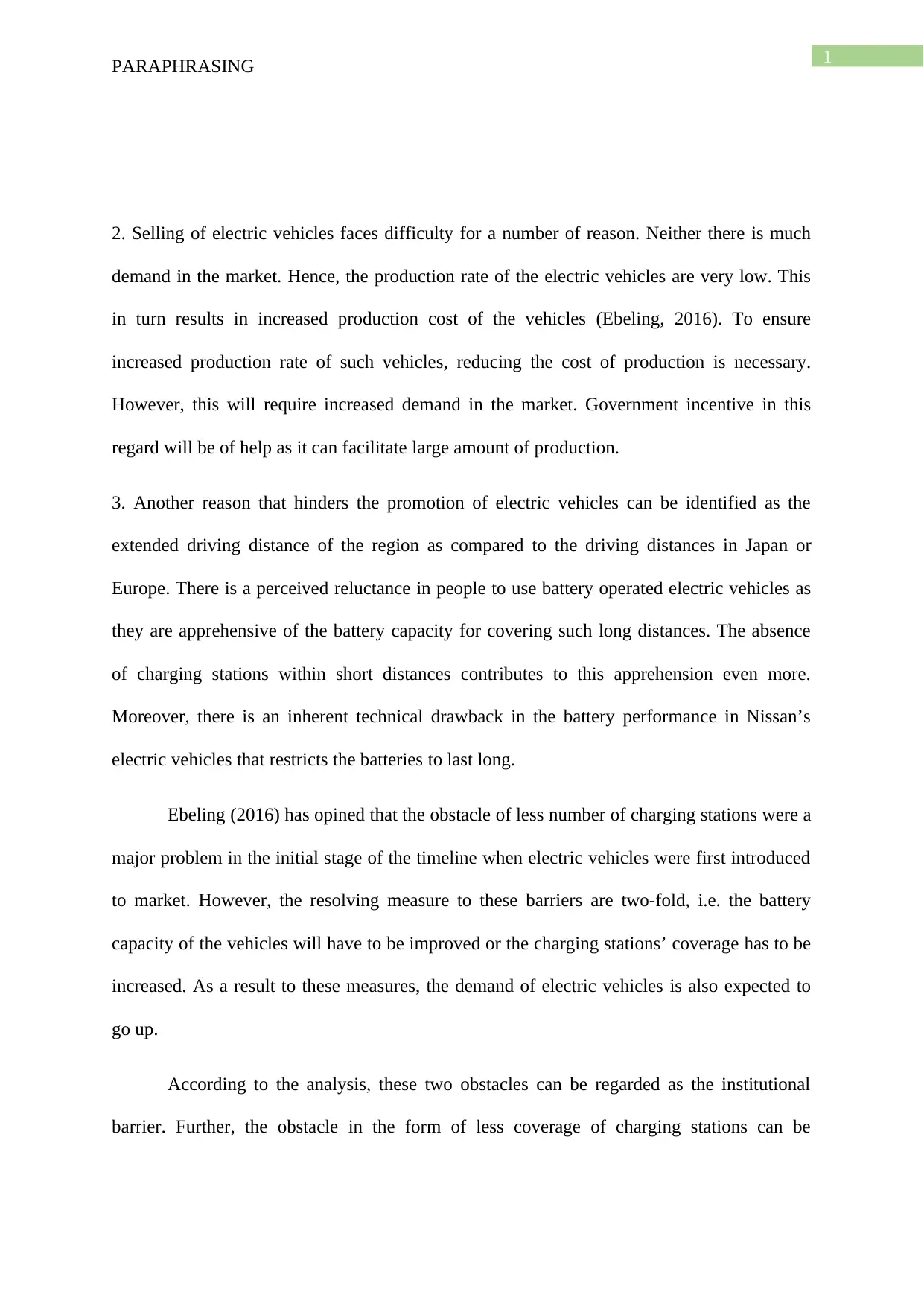
1
PARAPHRASING
2. Selling of electric vehicles faces difficulty for a number of reason. Neither there is much
demand in the market. Hence, the production rate of the electric vehicles are very low. This
in turn results in increased production cost of the vehicles (Ebeling, 2016). To ensure
increased production rate of such vehicles, reducing the cost of production is necessary.
However, this will require increased demand in the market. Government incentive in this
regard will be of help as it can facilitate large amount of production.
3. Another reason that hinders the promotion of electric vehicles can be identified as the
extended driving distance of the region as compared to the driving distances in Japan or
Europe. There is a perceived reluctance in people to use battery operated electric vehicles as
they are apprehensive of the battery capacity for covering such long distances. The absence
of charging stations within short distances contributes to this apprehension even more.
Moreover, there is an inherent technical drawback in the battery performance in Nissan’s
electric vehicles that restricts the batteries to last long.
Ebeling (2016) has opined that the obstacle of less number of charging stations were a
major problem in the initial stage of the timeline when electric vehicles were first introduced
to market. However, the resolving measure to these barriers are two-fold, i.e. the battery
capacity of the vehicles will have to be improved or the charging stations’ coverage has to be
increased. As a result to these measures, the demand of electric vehicles is also expected to
go up.
According to the analysis, these two obstacles can be regarded as the institutional
barrier. Further, the obstacle in the form of less coverage of charging stations can be
PARAPHRASING
2. Selling of electric vehicles faces difficulty for a number of reason. Neither there is much
demand in the market. Hence, the production rate of the electric vehicles are very low. This
in turn results in increased production cost of the vehicles (Ebeling, 2016). To ensure
increased production rate of such vehicles, reducing the cost of production is necessary.
However, this will require increased demand in the market. Government incentive in this
regard will be of help as it can facilitate large amount of production.
3. Another reason that hinders the promotion of electric vehicles can be identified as the
extended driving distance of the region as compared to the driving distances in Japan or
Europe. There is a perceived reluctance in people to use battery operated electric vehicles as
they are apprehensive of the battery capacity for covering such long distances. The absence
of charging stations within short distances contributes to this apprehension even more.
Moreover, there is an inherent technical drawback in the battery performance in Nissan’s
electric vehicles that restricts the batteries to last long.
Ebeling (2016) has opined that the obstacle of less number of charging stations were a
major problem in the initial stage of the timeline when electric vehicles were first introduced
to market. However, the resolving measure to these barriers are two-fold, i.e. the battery
capacity of the vehicles will have to be improved or the charging stations’ coverage has to be
increased. As a result to these measures, the demand of electric vehicles is also expected to
go up.
According to the analysis, these two obstacles can be regarded as the institutional
barrier. Further, the obstacle in the form of less coverage of charging stations can be
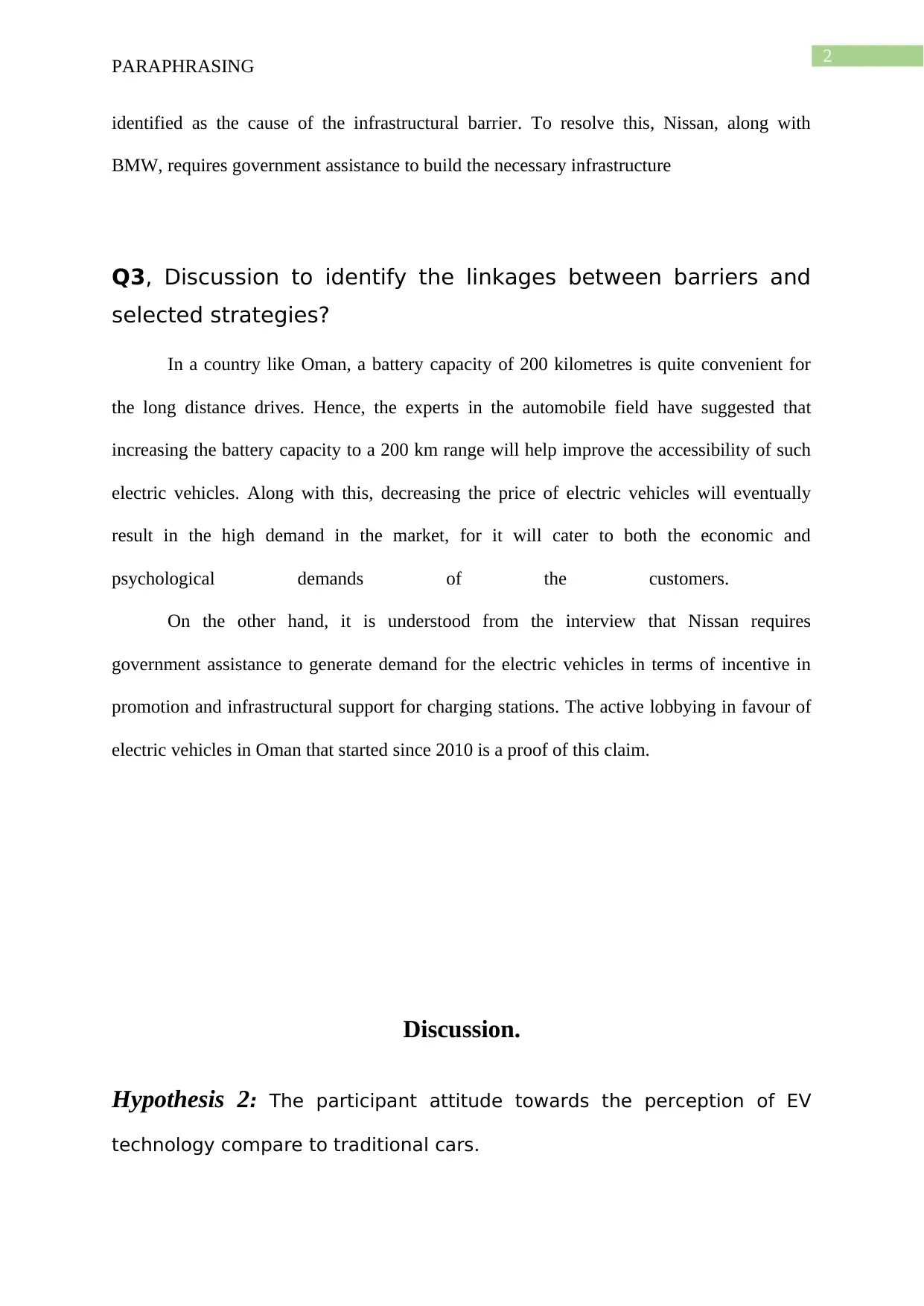
2
PARAPHRASING
identified as the cause of the infrastructural barrier. To resolve this, Nissan, along with
BMW, requires government assistance to build the necessary infrastructure
Q3, Discussion to identify the linkages between barriers and
selected strategies?
In a country like Oman, a battery capacity of 200 kilometres is quite convenient for
the long distance drives. Hence, the experts in the automobile field have suggested that
increasing the battery capacity to a 200 km range will help improve the accessibility of such
electric vehicles. Along with this, decreasing the price of electric vehicles will eventually
result in the high demand in the market, for it will cater to both the economic and
psychological demands of the customers.
On the other hand, it is understood from the interview that Nissan requires
government assistance to generate demand for the electric vehicles in terms of incentive in
promotion and infrastructural support for charging stations. The active lobbying in favour of
electric vehicles in Oman that started since 2010 is a proof of this claim.
Discussion.
Hypothesis 2: The participant attitude towards the perception of EV
technology compare to traditional cars.
PARAPHRASING
identified as the cause of the infrastructural barrier. To resolve this, Nissan, along with
BMW, requires government assistance to build the necessary infrastructure
Q3, Discussion to identify the linkages between barriers and
selected strategies?
In a country like Oman, a battery capacity of 200 kilometres is quite convenient for
the long distance drives. Hence, the experts in the automobile field have suggested that
increasing the battery capacity to a 200 km range will help improve the accessibility of such
electric vehicles. Along with this, decreasing the price of electric vehicles will eventually
result in the high demand in the market, for it will cater to both the economic and
psychological demands of the customers.
On the other hand, it is understood from the interview that Nissan requires
government assistance to generate demand for the electric vehicles in terms of incentive in
promotion and infrastructural support for charging stations. The active lobbying in favour of
electric vehicles in Oman that started since 2010 is a proof of this claim.
Discussion.
Hypothesis 2: The participant attitude towards the perception of EV
technology compare to traditional cars.

3
PARAPHRASING
Safety:
Another barrier that is identified in the present analysis is
understood as the probable increased risk of accident in case of the EVs as
compared to internal combustion engine vehicles. The major issues in this
regard are collision and electrical safety as well as the absence of engine
noise. It is observed that consumers are apprehensive of using the
Lithium-Ion batteries as it may lead to overheating or short circuits. As a
protective measure, integration of electronic systems may be suggested
in the board computer that assists the driver with battery capacity and
heating problems beforehand. This will be effective in avoiding accidents.
The probability of collision risks could be minimized by utilizing more
quality tests. Moreover, the absence of engine noise can be replaced by
some sort of artificial noise which might help in alarming others prior to
any accidents.
Safety training programmes can be useful in reducing this specific
barrier as well. This training programme may be offered in both offline and
online modes. The online sessions will provide useful information
regarding safety and technical issues, whereas the offline sessions will
provide first-hand experience of driving and road safety measures. This
‘on the road’ driving experience of electric vehicles will also encourage
people to choose EVs for the joy of driving it. Furthermore, to ensure
safety measures, fire brigade, emergency medical service providers, tow
truck drivers and police are to be given specialized training as well.
PARAPHRASING
Safety:
Another barrier that is identified in the present analysis is
understood as the probable increased risk of accident in case of the EVs as
compared to internal combustion engine vehicles. The major issues in this
regard are collision and electrical safety as well as the absence of engine
noise. It is observed that consumers are apprehensive of using the
Lithium-Ion batteries as it may lead to overheating or short circuits. As a
protective measure, integration of electronic systems may be suggested
in the board computer that assists the driver with battery capacity and
heating problems beforehand. This will be effective in avoiding accidents.
The probability of collision risks could be minimized by utilizing more
quality tests. Moreover, the absence of engine noise can be replaced by
some sort of artificial noise which might help in alarming others prior to
any accidents.
Safety training programmes can be useful in reducing this specific
barrier as well. This training programme may be offered in both offline and
online modes. The online sessions will provide useful information
regarding safety and technical issues, whereas the offline sessions will
provide first-hand experience of driving and road safety measures. This
‘on the road’ driving experience of electric vehicles will also encourage
people to choose EVs for the joy of driving it. Furthermore, to ensure
safety measures, fire brigade, emergency medical service providers, tow
truck drivers and police are to be given specialized training as well.
Secure Best Marks with AI Grader
Need help grading? Try our AI Grader for instant feedback on your assignments.
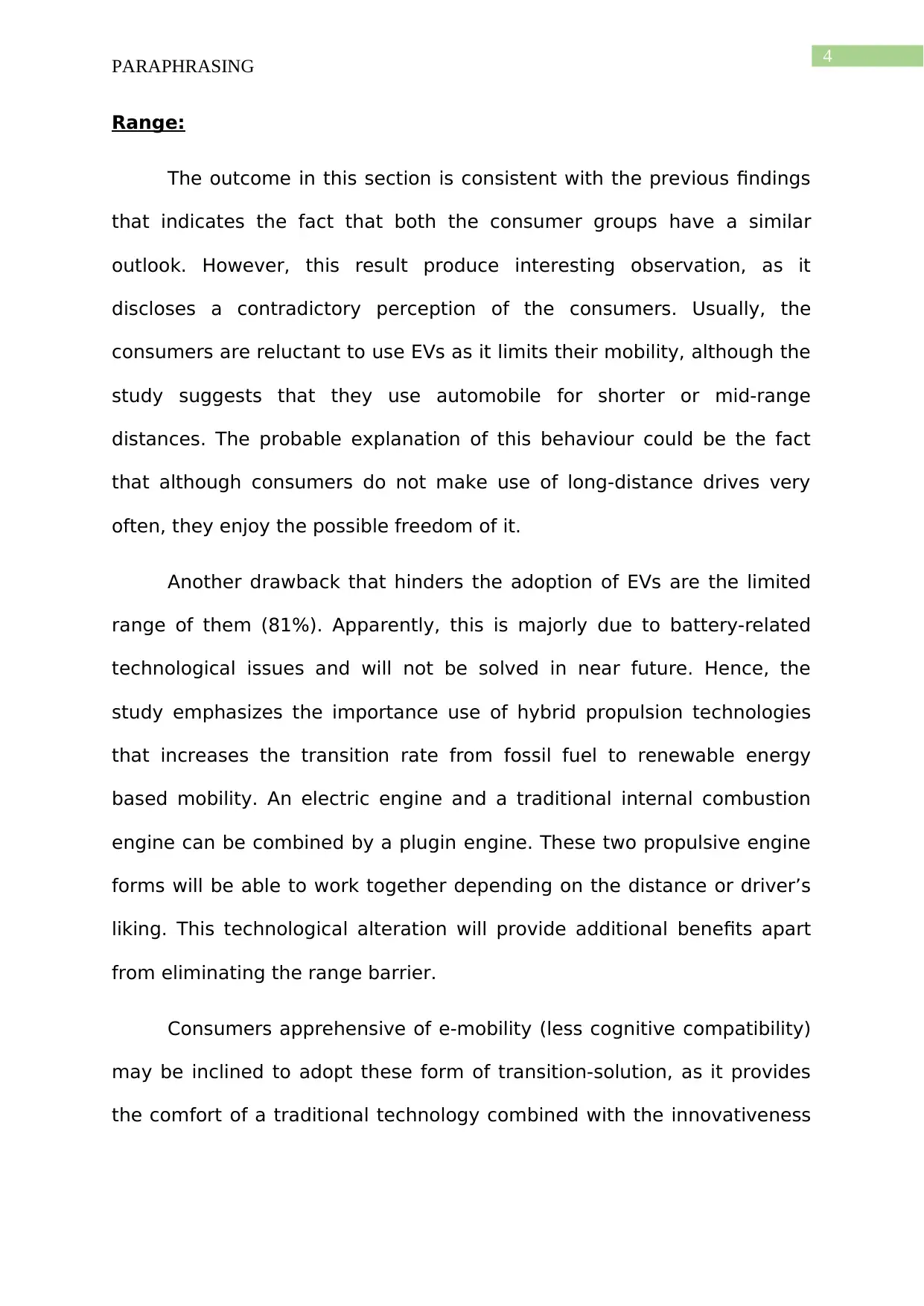
4
PARAPHRASING
Range:
The outcome in this section is consistent with the previous findings
that indicates the fact that both the consumer groups have a similar
outlook. However, this result produce interesting observation, as it
discloses a contradictory perception of the consumers. Usually, the
consumers are reluctant to use EVs as it limits their mobility, although the
study suggests that they use automobile for shorter or mid-range
distances. The probable explanation of this behaviour could be the fact
that although consumers do not make use of long-distance drives very
often, they enjoy the possible freedom of it.
Another drawback that hinders the adoption of EVs are the limited
range of them (81%). Apparently, this is majorly due to battery-related
technological issues and will not be solved in near future. Hence, the
study emphasizes the importance use of hybrid propulsion technologies
that increases the transition rate from fossil fuel to renewable energy
based mobility. An electric engine and a traditional internal combustion
engine can be combined by a plugin engine. These two propulsive engine
forms will be able to work together depending on the distance or driver’s
liking. This technological alteration will provide additional benefits apart
from eliminating the range barrier.
Consumers apprehensive of e-mobility (less cognitive compatibility)
may be inclined to adopt these form of transition-solution, as it provides
the comfort of a traditional technology combined with the innovativeness
PARAPHRASING
Range:
The outcome in this section is consistent with the previous findings
that indicates the fact that both the consumer groups have a similar
outlook. However, this result produce interesting observation, as it
discloses a contradictory perception of the consumers. Usually, the
consumers are reluctant to use EVs as it limits their mobility, although the
study suggests that they use automobile for shorter or mid-range
distances. The probable explanation of this behaviour could be the fact
that although consumers do not make use of long-distance drives very
often, they enjoy the possible freedom of it.
Another drawback that hinders the adoption of EVs are the limited
range of them (81%). Apparently, this is majorly due to battery-related
technological issues and will not be solved in near future. Hence, the
study emphasizes the importance use of hybrid propulsion technologies
that increases the transition rate from fossil fuel to renewable energy
based mobility. An electric engine and a traditional internal combustion
engine can be combined by a plugin engine. These two propulsive engine
forms will be able to work together depending on the distance or driver’s
liking. This technological alteration will provide additional benefits apart
from eliminating the range barrier.
Consumers apprehensive of e-mobility (less cognitive compatibility)
may be inclined to adopt these form of transition-solution, as it provides
the comfort of a traditional technology combined with the innovativeness
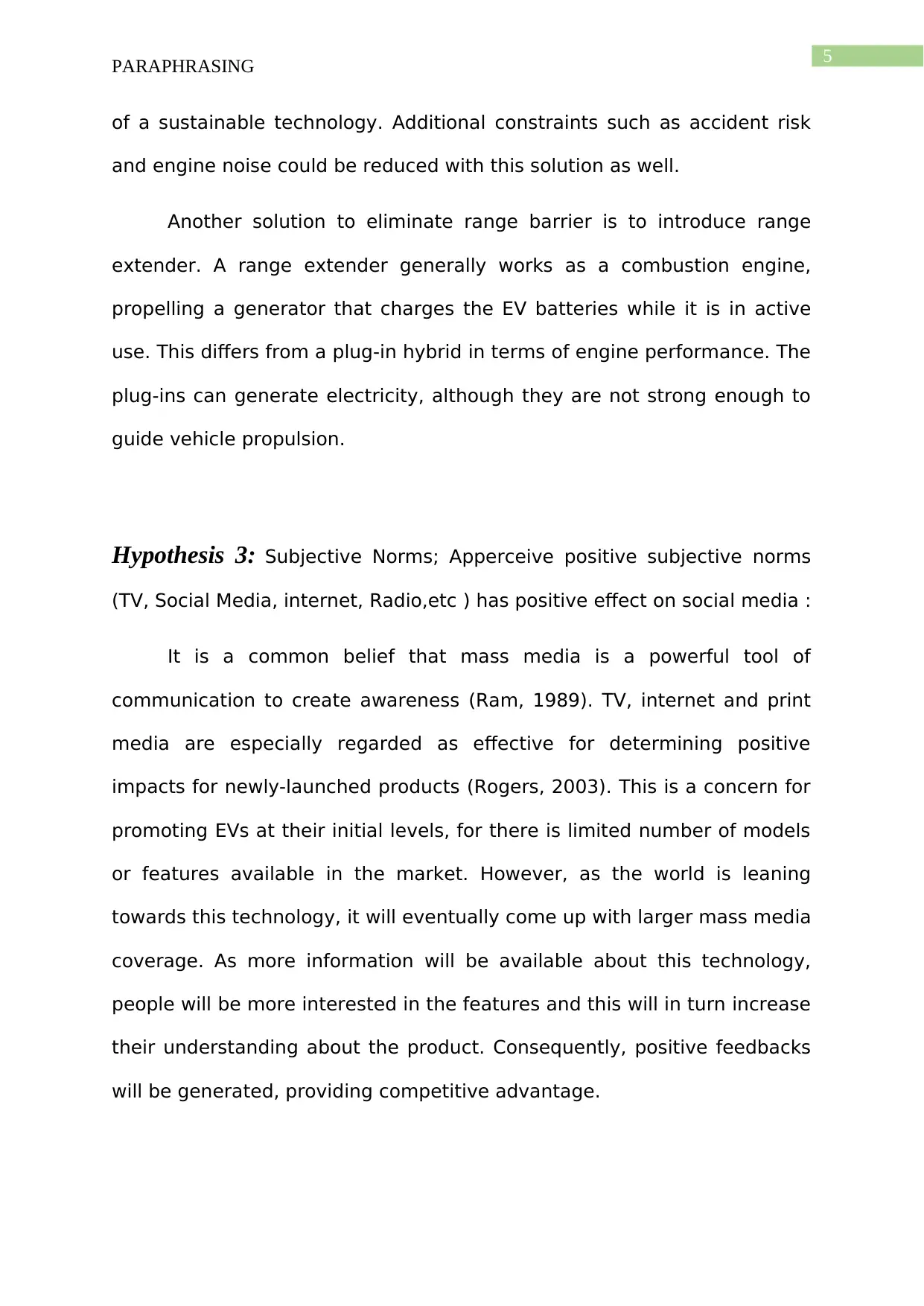
5
PARAPHRASING
of a sustainable technology. Additional constraints such as accident risk
and engine noise could be reduced with this solution as well.
Another solution to eliminate range barrier is to introduce range
extender. A range extender generally works as a combustion engine,
propelling a generator that charges the EV batteries while it is in active
use. This differs from a plug-in hybrid in terms of engine performance. The
plug-ins can generate electricity, although they are not strong enough to
guide vehicle propulsion.
Hypothesis 3: Subjective Norms; Apperceive positive subjective norms
(TV, Social Media, internet, Radio,etc ) has positive effect on social media :
It is a common belief that mass media is a powerful tool of
communication to create awareness (Ram, 1989). TV, internet and print
media are especially regarded as effective for determining positive
impacts for newly-launched products (Rogers, 2003). This is a concern for
promoting EVs at their initial levels, for there is limited number of models
or features available in the market. However, as the world is leaning
towards this technology, it will eventually come up with larger mass media
coverage. As more information will be available about this technology,
people will be more interested in the features and this will in turn increase
their understanding about the product. Consequently, positive feedbacks
will be generated, providing competitive advantage.
PARAPHRASING
of a sustainable technology. Additional constraints such as accident risk
and engine noise could be reduced with this solution as well.
Another solution to eliminate range barrier is to introduce range
extender. A range extender generally works as a combustion engine,
propelling a generator that charges the EV batteries while it is in active
use. This differs from a plug-in hybrid in terms of engine performance. The
plug-ins can generate electricity, although they are not strong enough to
guide vehicle propulsion.
Hypothesis 3: Subjective Norms; Apperceive positive subjective norms
(TV, Social Media, internet, Radio,etc ) has positive effect on social media :
It is a common belief that mass media is a powerful tool of
communication to create awareness (Ram, 1989). TV, internet and print
media are especially regarded as effective for determining positive
impacts for newly-launched products (Rogers, 2003). This is a concern for
promoting EVs at their initial levels, for there is limited number of models
or features available in the market. However, as the world is leaning
towards this technology, it will eventually come up with larger mass media
coverage. As more information will be available about this technology,
people will be more interested in the features and this will in turn increase
their understanding about the product. Consequently, positive feedbacks
will be generated, providing competitive advantage.
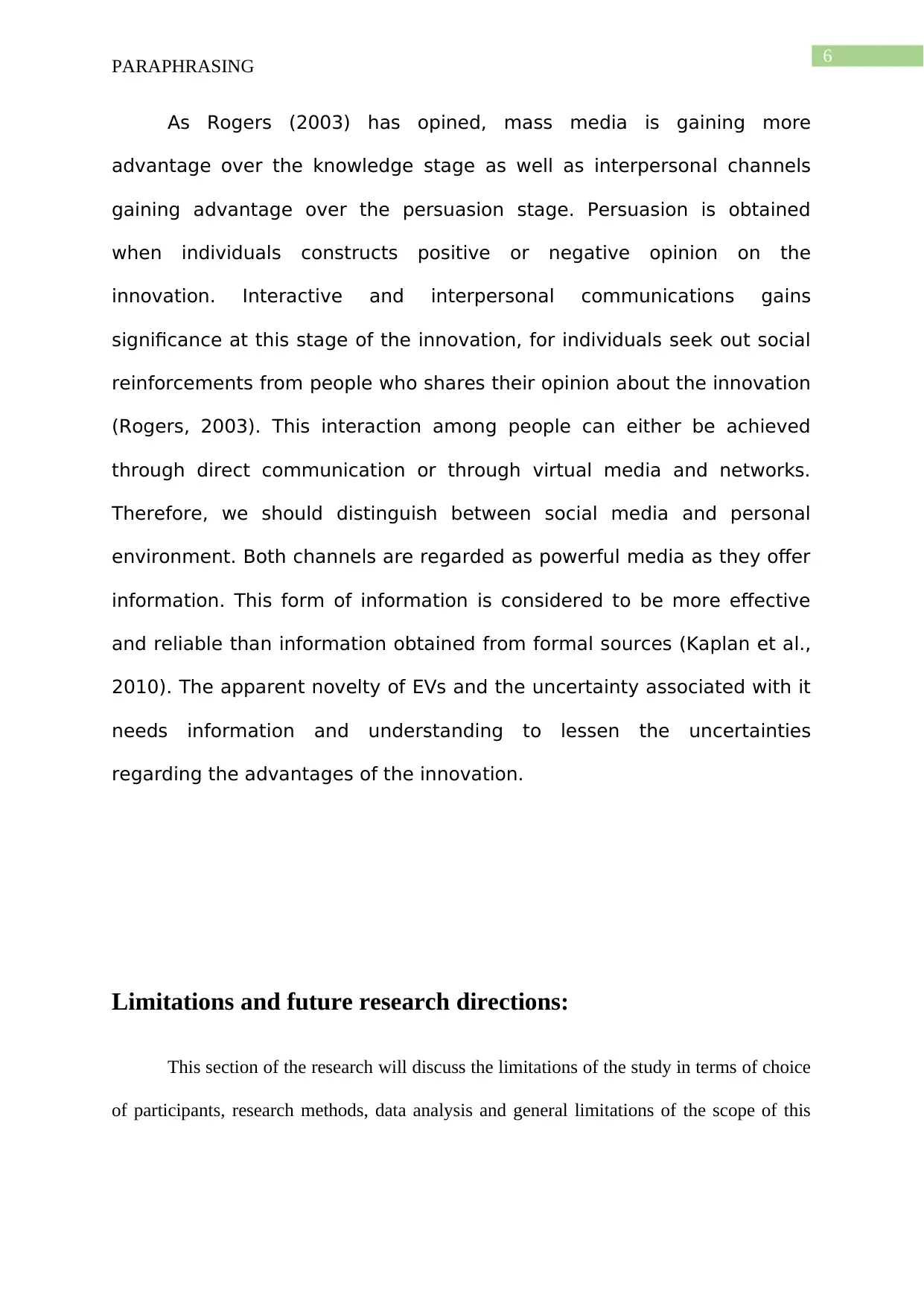
6
PARAPHRASING
As Rogers (2003) has opined, mass media is gaining more
advantage over the knowledge stage as well as interpersonal channels
gaining advantage over the persuasion stage. Persuasion is obtained
when individuals constructs positive or negative opinion on the
innovation. Interactive and interpersonal communications gains
significance at this stage of the innovation, for individuals seek out social
reinforcements from people who shares their opinion about the innovation
(Rogers, 2003). This interaction among people can either be achieved
through direct communication or through virtual media and networks.
Therefore, we should distinguish between social media and personal
environment. Both channels are regarded as powerful media as they offer
information. This form of information is considered to be more effective
and reliable than information obtained from formal sources (Kaplan et al.,
2010). The apparent novelty of EVs and the uncertainty associated with it
needs information and understanding to lessen the uncertainties
regarding the advantages of the innovation.
Limitations and future research directions:
This section of the research will discuss the limitations of the study in terms of choice
of participants, research methods, data analysis and general limitations of the scope of this
PARAPHRASING
As Rogers (2003) has opined, mass media is gaining more
advantage over the knowledge stage as well as interpersonal channels
gaining advantage over the persuasion stage. Persuasion is obtained
when individuals constructs positive or negative opinion on the
innovation. Interactive and interpersonal communications gains
significance at this stage of the innovation, for individuals seek out social
reinforcements from people who shares their opinion about the innovation
(Rogers, 2003). This interaction among people can either be achieved
through direct communication or through virtual media and networks.
Therefore, we should distinguish between social media and personal
environment. Both channels are regarded as powerful media as they offer
information. This form of information is considered to be more effective
and reliable than information obtained from formal sources (Kaplan et al.,
2010). The apparent novelty of EVs and the uncertainty associated with it
needs information and understanding to lessen the uncertainties
regarding the advantages of the innovation.
Limitations and future research directions:
This section of the research will discuss the limitations of the study in terms of choice
of participants, research methods, data analysis and general limitations of the scope of this
Paraphrase This Document
Need a fresh take? Get an instant paraphrase of this document with our AI Paraphraser
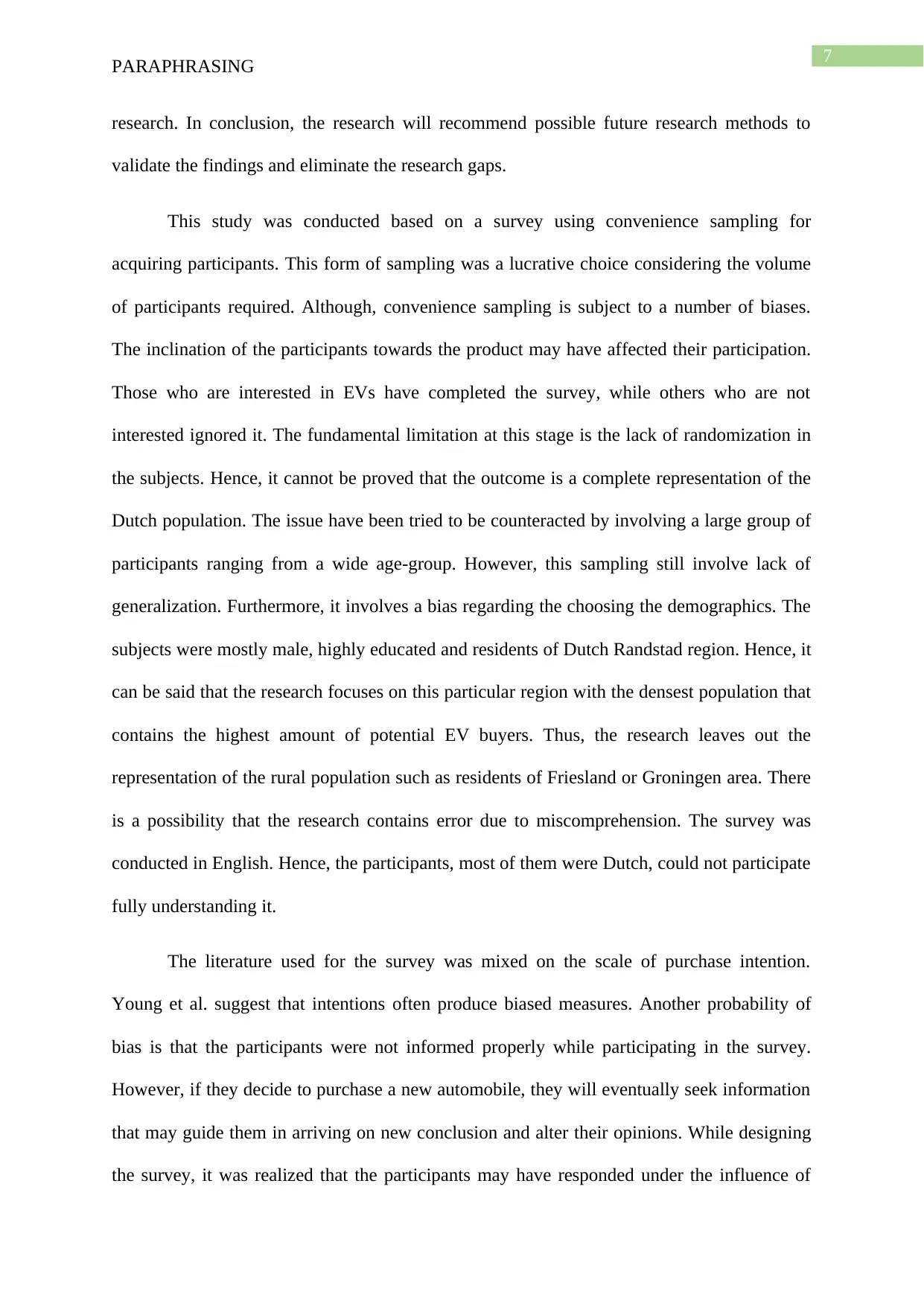
7
PARAPHRASING
research. In conclusion, the research will recommend possible future research methods to
validate the findings and eliminate the research gaps.
This study was conducted based on a survey using convenience sampling for
acquiring participants. This form of sampling was a lucrative choice considering the volume
of participants required. Although, convenience sampling is subject to a number of biases.
The inclination of the participants towards the product may have affected their participation.
Those who are interested in EVs have completed the survey, while others who are not
interested ignored it. The fundamental limitation at this stage is the lack of randomization in
the subjects. Hence, it cannot be proved that the outcome is a complete representation of the
Dutch population. The issue have been tried to be counteracted by involving a large group of
participants ranging from a wide age-group. However, this sampling still involve lack of
generalization. Furthermore, it involves a bias regarding the choosing the demographics. The
subjects were mostly male, highly educated and residents of Dutch Randstad region. Hence, it
can be said that the research focuses on this particular region with the densest population that
contains the highest amount of potential EV buyers. Thus, the research leaves out the
representation of the rural population such as residents of Friesland or Groningen area. There
is a possibility that the research contains error due to miscomprehension. The survey was
conducted in English. Hence, the participants, most of them were Dutch, could not participate
fully understanding it.
The literature used for the survey was mixed on the scale of purchase intention.
Young et al. suggest that intentions often produce biased measures. Another probability of
bias is that the participants were not informed properly while participating in the survey.
However, if they decide to purchase a new automobile, they will eventually seek information
that may guide them in arriving on new conclusion and alter their opinions. While designing
the survey, it was realized that the participants may have responded under the influence of
PARAPHRASING
research. In conclusion, the research will recommend possible future research methods to
validate the findings and eliminate the research gaps.
This study was conducted based on a survey using convenience sampling for
acquiring participants. This form of sampling was a lucrative choice considering the volume
of participants required. Although, convenience sampling is subject to a number of biases.
The inclination of the participants towards the product may have affected their participation.
Those who are interested in EVs have completed the survey, while others who are not
interested ignored it. The fundamental limitation at this stage is the lack of randomization in
the subjects. Hence, it cannot be proved that the outcome is a complete representation of the
Dutch population. The issue have been tried to be counteracted by involving a large group of
participants ranging from a wide age-group. However, this sampling still involve lack of
generalization. Furthermore, it involves a bias regarding the choosing the demographics. The
subjects were mostly male, highly educated and residents of Dutch Randstad region. Hence, it
can be said that the research focuses on this particular region with the densest population that
contains the highest amount of potential EV buyers. Thus, the research leaves out the
representation of the rural population such as residents of Friesland or Groningen area. There
is a possibility that the research contains error due to miscomprehension. The survey was
conducted in English. Hence, the participants, most of them were Dutch, could not participate
fully understanding it.
The literature used for the survey was mixed on the scale of purchase intention.
Young et al. suggest that intentions often produce biased measures. Another probability of
bias is that the participants were not informed properly while participating in the survey.
However, if they decide to purchase a new automobile, they will eventually seek information
that may guide them in arriving on new conclusion and alter their opinions. While designing
the survey, it was realized that the participants may have responded under the influence of
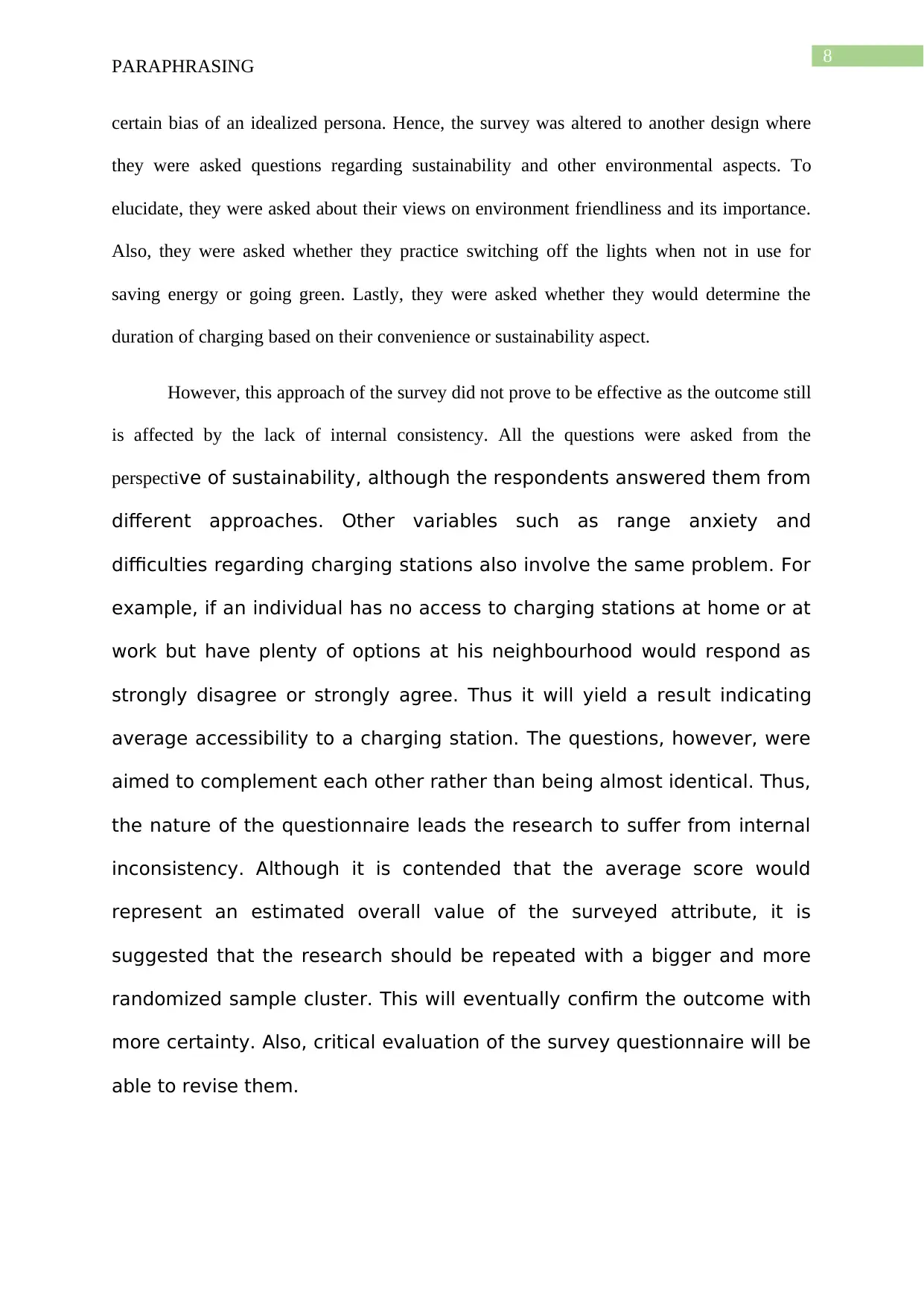
8
PARAPHRASING
certain bias of an idealized persona. Hence, the survey was altered to another design where
they were asked questions regarding sustainability and other environmental aspects. To
elucidate, they were asked about their views on environment friendliness and its importance.
Also, they were asked whether they practice switching off the lights when not in use for
saving energy or going green. Lastly, they were asked whether they would determine the
duration of charging based on their convenience or sustainability aspect.
However, this approach of the survey did not prove to be effective as the outcome still
is affected by the lack of internal consistency. All the questions were asked from the
perspective of sustainability, although the respondents answered them from
different approaches. Other variables such as range anxiety and
difficulties regarding charging stations also involve the same problem. For
example, if an individual has no access to charging stations at home or at
work but have plenty of options at his neighbourhood would respond as
strongly disagree or strongly agree. Thus it will yield a result indicating
average accessibility to a charging station. The questions, however, were
aimed to complement each other rather than being almost identical. Thus,
the nature of the questionnaire leads the research to suffer from internal
inconsistency. Although it is contended that the average score would
represent an estimated overall value of the surveyed attribute, it is
suggested that the research should be repeated with a bigger and more
randomized sample cluster. This will eventually confirm the outcome with
more certainty. Also, critical evaluation of the survey questionnaire will be
able to revise them.
PARAPHRASING
certain bias of an idealized persona. Hence, the survey was altered to another design where
they were asked questions regarding sustainability and other environmental aspects. To
elucidate, they were asked about their views on environment friendliness and its importance.
Also, they were asked whether they practice switching off the lights when not in use for
saving energy or going green. Lastly, they were asked whether they would determine the
duration of charging based on their convenience or sustainability aspect.
However, this approach of the survey did not prove to be effective as the outcome still
is affected by the lack of internal consistency. All the questions were asked from the
perspective of sustainability, although the respondents answered them from
different approaches. Other variables such as range anxiety and
difficulties regarding charging stations also involve the same problem. For
example, if an individual has no access to charging stations at home or at
work but have plenty of options at his neighbourhood would respond as
strongly disagree or strongly agree. Thus it will yield a result indicating
average accessibility to a charging station. The questions, however, were
aimed to complement each other rather than being almost identical. Thus,
the nature of the questionnaire leads the research to suffer from internal
inconsistency. Although it is contended that the average score would
represent an estimated overall value of the surveyed attribute, it is
suggested that the research should be repeated with a bigger and more
randomized sample cluster. This will eventually confirm the outcome with
more certainty. Also, critical evaluation of the survey questionnaire will be
able to revise them.
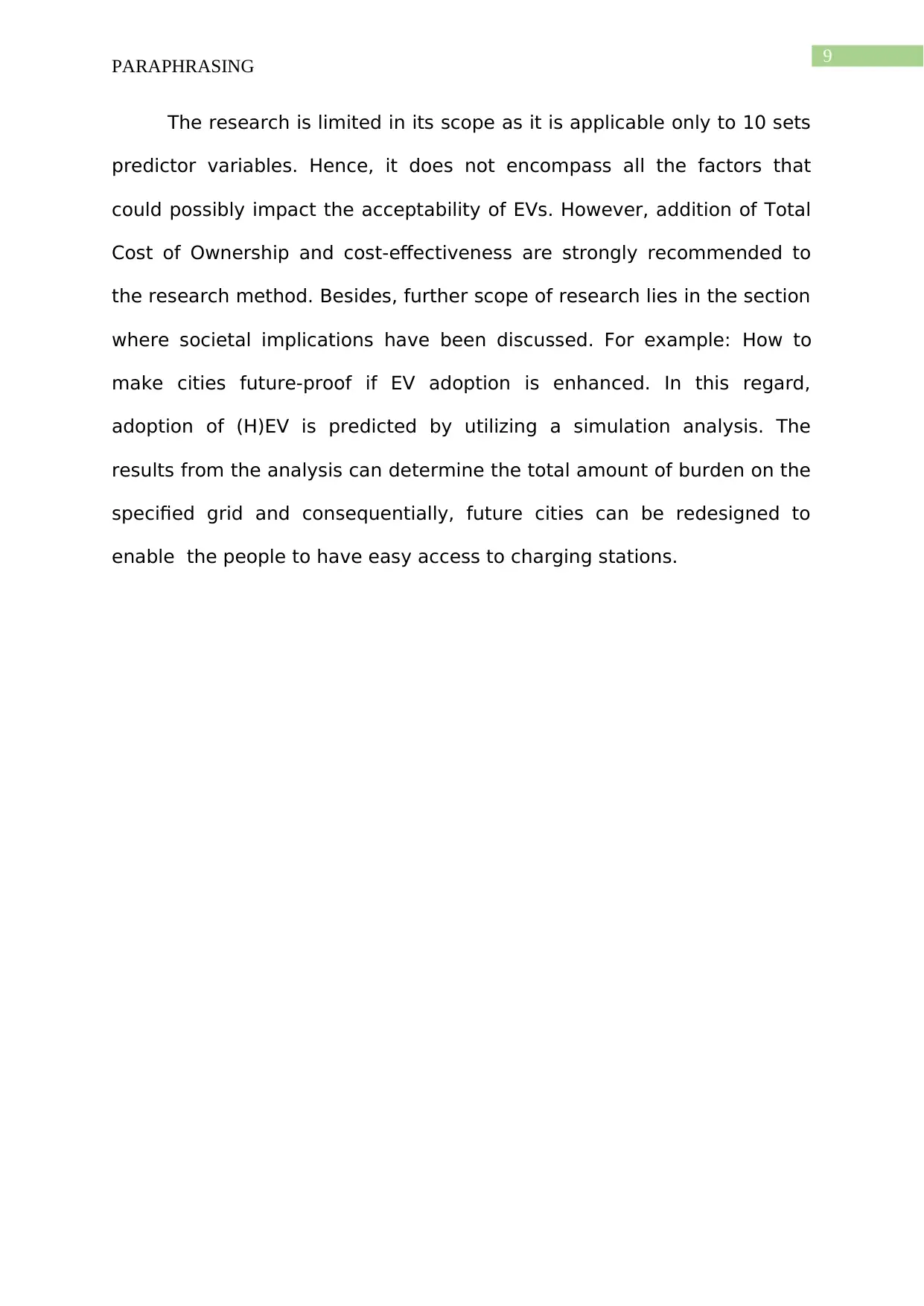
9
PARAPHRASING
The research is limited in its scope as it is applicable only to 10 sets
predictor variables. Hence, it does not encompass all the factors that
could possibly impact the acceptability of EVs. However, addition of Total
Cost of Ownership and cost-effectiveness are strongly recommended to
the research method. Besides, further scope of research lies in the section
where societal implications have been discussed. For example: How to
make cities future-proof if EV adoption is enhanced. In this regard,
adoption of (H)EV is predicted by utilizing a simulation analysis. The
results from the analysis can determine the total amount of burden on the
specified grid and consequentially, future cities can be redesigned to
enable the people to have easy access to charging stations.
PARAPHRASING
The research is limited in its scope as it is applicable only to 10 sets
predictor variables. Hence, it does not encompass all the factors that
could possibly impact the acceptability of EVs. However, addition of Total
Cost of Ownership and cost-effectiveness are strongly recommended to
the research method. Besides, further scope of research lies in the section
where societal implications have been discussed. For example: How to
make cities future-proof if EV adoption is enhanced. In this regard,
adoption of (H)EV is predicted by utilizing a simulation analysis. The
results from the analysis can determine the total amount of burden on the
specified grid and consequentially, future cities can be redesigned to
enable the people to have easy access to charging stations.
1 out of 10
Related Documents
Your All-in-One AI-Powered Toolkit for Academic Success.
+13062052269
info@desklib.com
Available 24*7 on WhatsApp / Email
![[object Object]](/_next/static/media/star-bottom.7253800d.svg)
Unlock your academic potential
© 2024 | Zucol Services PVT LTD | All rights reserved.
